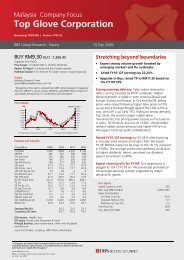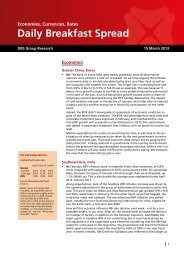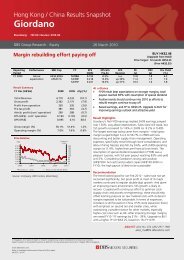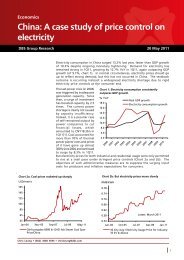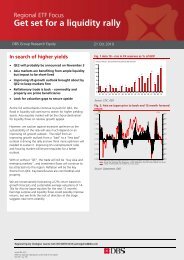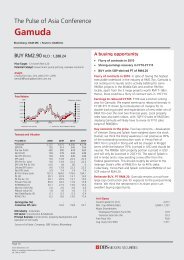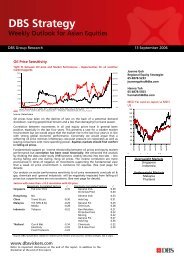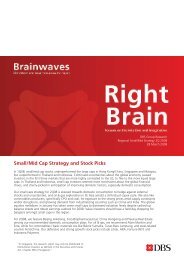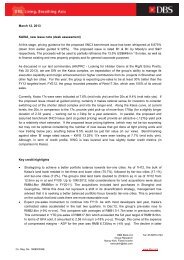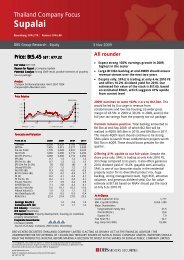Economics Markets Strategy - the DBS Vickers Securities Equities ...
Economics Markets Strategy - the DBS Vickers Securities Equities ...
Economics Markets Strategy - the DBS Vickers Securities Equities ...
You also want an ePaper? Increase the reach of your titles
YUMPU automatically turns print PDFs into web optimized ePapers that Google loves.
<strong>Economics</strong> – <strong>Markets</strong> – <strong>Strategy</strong><br />
<strong>Economics</strong>: Korea<br />
moving ahead of <strong>the</strong> curve (Chart 6). Last year for instance, <strong>the</strong>y hiked rates as<br />
early as 3Q07 when growth had risen above potential for merely one quarter,<br />
and inflation stayed fairly stable at <strong>the</strong> lower-end of policy target (2.5-3.5%).<br />
Thanks to <strong>the</strong> well-controlled consumer prices last year (2.5%), <strong>the</strong> inflation<br />
average from Jan07 to May08 is 3.0%, only at <strong>the</strong> middle point of <strong>the</strong> policy<br />
target (which is set for inflation average in 2007-2009). Indeed, a forward-looking<br />
central bank should understand that cost-push inflation will unlikely sustain<br />
very long as growth will also be dragged. The BOK is likely to make rate decision<br />
based on growth trend, more than <strong>the</strong> lagging inflation data.<br />
The BOK is likely to<br />
focus more on<br />
growth than on<br />
inflation<br />
Meanwhile, recent years of strong capital inflows, currency intervention and<br />
monetary sterilization have left <strong>the</strong> BOK with large amount of foreign reserves<br />
(27% of GDP, vs. 6% in 1996) and monetary stabilization bonds (17% of GDP, vs.<br />
4% in 1996) (Chart 7). It appears that <strong>the</strong> BOK has injected liquidity into financial<br />
system ever since 4Q07 to tame <strong>the</strong> rises in market interest rates, as evidenced<br />
by <strong>the</strong> gradual declines in <strong>the</strong> amount of outstanding MSBs (Chart 8). Also, <strong>the</strong><br />
Chart 7: The BOK has <strong>the</strong> capacity of intervention<br />
%<br />
35<br />
Foreign Reserve / GDP<br />
30<br />
MSBs / GDP<br />
25<br />
20<br />
15<br />
Chart 8: The BOK discharging liquidity<br />
won trn<br />
200<br />
150<br />
100<br />
10<br />
5<br />
50<br />
Outstanding MSBs<br />
0<br />
1991 1993 1995 1997 1999 2001 2003 2005 2007<br />
0<br />
Apr-98 Apr-00 Apr-02 Apr-04 Apr-06 Apr-08<br />
BOK has <strong>the</strong> capacity to intervene <strong>the</strong> FX market and prevent <strong>the</strong> won from<br />
excessive depreciation, if required. In fact, <strong>the</strong> won’s sharp drop in March-May<br />
was partly fuelled by <strong>the</strong> government’s earlier enthusiasm of using a weaker<br />
won to stimulate exports. Since <strong>the</strong> BOK heavily intervened in late-May and<br />
<strong>the</strong> government reduced <strong>the</strong> talks on <strong>the</strong> benefits of a weaker won, <strong>the</strong> won/<br />
dollar rate has stabilized.<br />
Overall, we think Korea still has sufficient fiscal and monetary instruments to<br />
help it survive <strong>the</strong> current difficulties. Growth is likely to remain low this quarter<br />
and <strong>the</strong> next given <strong>the</strong> prevailing external and internal headwinds. The timing<br />
of a recovery would largely hinge on <strong>the</strong> implementation of fiscal stimulus,<br />
and BOK policies. We downgraded 2008 GDP growth forecast to 4.6% from<br />
4.8%, but maintain 2009 forecast at an above-potential 5.0% for now.<br />
The timing of<br />
growth recovery<br />
hinges on <strong>the</strong><br />
implementation of<br />
fiscal stimulus<br />
91



